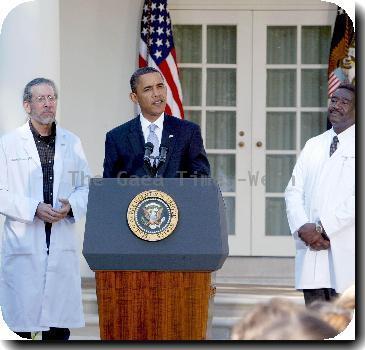AP IMPACT: When Obama and experts sit down to talk jobs, 4 ideas to put on the table
By Christopher S. Rugaber, APWednesday, December 2, 2009
AP IMPACT: For White House job summit, 4 ideas
The question is jobs, but there’s no one right answer.
When President Barack Obama convenes a jobs summit Thursday, he and all the brainstorming economists and CEOs, small business owners and labor leaders face a dire predicament with no simple solutions.
The nation’s unemployment rate has climbed to 10.2 percent, the highest since 1983. Some 15.7 million Americans are out of work. The average jobless worker has been unemployed for more than six months.
Meanwhile, the immediate benefits of the economic stimulus passed by Congress earlier this year are fading. The recession may be over, but analysts say many of the jobs lost in the downturn probably will not return and high unemployment is likely to persist.
But doing nothing is not an option. The Associated Press spoke with a variety of experts, looking for ways to create and preserve jobs. They offer four strategies they say should be in the mix at the jobs summit — hardly an exhaustive list, but certainly a starting point for discussion.
WORK-SHARING
When home construction fell sharply, orders coming in to Gary Melillo’s department at a factory in Cranston, R.I. suffered. Workers at Taco Inc. continued building heating, ventilation and air conditioning equipment to fill the plant’s inventory. But if business didn’t pick up, it was clear there wouldn’t be enough work to go around.
“It would be very scary to be totally laid off,” said Melillo, a 25-year veteran of the plant whose wife also works for Taco (pronounced TAKE-o). “That could be a double hit.”
Taco wanted to avoid layoffs. If it cut workers who average nearly 18 years on the job, it couldn’t be certain of getting them back when business picked up. Training new workers costs time and money. Instead, the company tried a strategy called work-sharing to spread the pain and preserve jobs.
Workers in some departments at Taco were cut back to either a three-day or four-day week. Unemployment insurance covered more than half their lost wages and they kept benefits including health insurance. This year, all Taco’s 292 production workers in Rhode Island and Massachusetts have been on work-sharing at some point, cut back to four-day weeks.
“If we had not been able to use the work-sharing program, I believe we would have seen some potential layoffs,” said Kyle Adamonis, Taco’s senior vice president of human resources.
Rhode Island is battling 12.9 percent unemployment, spurring interest in a program in place since the early 1990s. Employers have used work-share to avert the equivalent of 5,800 layoffs through October, quadrupling the program’s rolls from two years ago.
At least 17 states have some version of work-sharing. Some come with bureaucratic requirements that discourage employers and many programs are little known, said Dean Baker, co-director of the Center for Economic and Policy Research in Washington, D.C. But broader, more aggressive use of such programs could prevent job losses, which goes hand-in-hand with creating jobs, Baker said.
A similar strategy has helped cushion the recession’s blow in Germany, which is subsidizing the pay of thousands of workers assigned shorter hours. The government’s program covers as much as 67 percent of lost pay. By spring of this year, more than 2 million workers were registered for the program. Unemployment in Germany stands at 7.6 percent, down from earlier this year.
Work-sharing’s impact has been much more limited in the U.S. But on the production floor, Melillo says, it has provided a sense of relief.
“The work-sharing comes in and helps ease the pain,” he says. “I’m still working. That makes me feel good.”
TAX HOLIDAYS
Small businesses are a job engine in an expanding economy. But many are just trying to get by now in the face of slumping sales.
To help them avoid laying off workers and encourage them to hire new ones, some business groups are calling for a payroll tax holiday that would give all companies a break from Social Security and Medicare payroll taxes, which total 15 percent.
Half the tax is paid by the employer, the other half by the employee. Suspending the taxes would lower the cost of both existing and new workers while at the same time putting more money in the pockets of employees. That, in turn, could boost consumer spending, which powers about 70 percent of the economy.
“Our membership is saying that their number one problem is lost sales,” says Bill Rys, tax counsel for the National Federation of Independent Business. The group has been pushing a payroll tax holiday since last year, and estimates it could cost $300 billion.
A temporary break on payroll taxes would enable small business to keep more of the cash that is still coming in and “eliminate one cost of doing business,” he said.
Other economists favor a temporary tax cut targeted only at new hires. Companies that add to their payrolls would get a tax break, equal to perhaps 15 percent of pay for the new hires.
That would provide more “bang for the buck,” says Lawrence Katz, a professor at Harvard University, because it would cost taxpayers less than an across-the-board cut. On the other hand, it wouldn’t necessarily help companies struggling to keep their current workers, he admits.
A targeted tax cut could be “gamed” by employers, who might lay off some workers, only to hire them back as “new” employees to claim the credit. That can be prevented by requiring employers to increase their total payrolls to benefit, Katz said.
A NEW JOB CORPS
The New Deal programs of the 1930s were, by far, Washington’s best known effort to put people directly to work. But the federal government has paid to create jobs more recently and some experts say, drawing on lessons learned, the time is right to try again.
In the early 1970s, Bill Tracy was a novice local official in Jersey City, N.J. The city was strapped and short on police officers when the Nixon administration offered money for states and cities to hire unemployed workers. Tracy pushed to move officers from desk duty to the streets, then used federal money to fill the clerical jobs with the recently jobless. He hired others as unarmed guards for city parks and housing projects, a net gain of about 200 jobs.
The programs started under Nixon were expanded more than threefold under President Jimmy Carter — roughly $4.5 billion in 1978 to fund about 750,000 jobs nationwide.
The hiring went well beyond local police departments. In Portland, Ore., agencies hired unemployed Vietnam veterans, trained them in carpentry and put them to work renovating abandoned homes that were then sold. In Vanderburgh County, Ind., the tax assessor’s office used the money to hire people who combed through files of those owing property taxes and then went after evaders.
“This is a pretty effective way to get money into the economy and into the pockets of people so they can do something productive,” says Carl Van Horn, director of the Heldrich Center for Workforce Development at Rutgers University.
The Public Service Employment efforts of the late 1970s were not perfect. Critics charged that government money was used for wasteful projects and that the programs were ripe for patronage hiring. There was also concern that those hired would displace better paid workers. Tracy, who went on to direct New Jersey’s administration of those programs and is now retired to North Carolina, says some of the criticism was valid.
Waste is inevitable in such a program because it is designed to get money out fast to where it’s needed, which limits accountability, he says. But a new program could include better oversight, probably by having states monitor local administration of hiring, he said. Patronage could be limited by setting clear eligibility cutoffs, perhaps requiring that workers hired must have been unemployed for at least six months or a year.
If such a program were put in place, it could very quickly have an impact in areas where unemployment is high, he said.
“This is what we need,” Tracy said. “We need it now.”
DIRECT AID TO STATES AND CITIES
With money collected from taxes down and its budget under pressure, the Gary, Ind., school district had to find spending to cut. Nero Lawrence and more than 250 other administrators, teachers and custodians lost their jobs in the fallout.
When Lawrence, 64, was sent home in September, he considered opening his own counseling service. But a couple of weeks later, armed with about $6 million in stimulus money, the district called to offer him a new job. Lawrence returned to work as a “secondary transitional coach” at the Lew Wallace STEM Academy, grades 7-12 program focused on science, technology and engineering. He counsels at-risk students, makes sure they attend school, visits their families at home and does tutoring.
“It put me back in my element,” he said. “I can provide the services I was trained to provide.”
Other coaches hired with stimulus money work with teachers on improving instructional methods and train them to use new technology.
The pressures Gary faces are far from unique. One of the quickest, most direct ways for the federal government to keep people employed, many economists say, is to help state and local governments close their yawning budget gaps. The recession has sent tax revenue plunging, forcing states and cities to cut workers and services.
It’s likely to get worse. The Economic Policy Institute, a liberal think tank, estimates that states and localities face about $330 billion in shortfalls over the next two years. Providing $150 billion in budget relief would save or create more than 1 million jobs, EPI estimates.
Some economists argue the Obama administration’s stimulus package has already added jobs in this way. About $40 billion of the stimulus was intended to limit layoffs of teachers. The White House claims that part of the stimulus saved 325,000 jobs.
While some layoffs have taken place, the cuts “would have been substantially worse had it not been” for stimulus funding, says Harry Holzer, an economist at Georgetown University.
In Gary, the city’s schools rehired about 45 teachers and staff and added eight new positions after receiving stimulus money, Superintendent Myrtle Campbell says.
“It has helped us a great deal,” she said. “We were able to expand the academic day for our students and provide more remedial instruction.”
Still, the assistance is only for two years and Campbell, like other school officials, worries about what will happen when the funds run out.
“The student needs will still be there, even if the dollars are not,” she said.
AP Business Writer George Frey in Frankfurt contributed to this story.
Tags: Barack Obama, District Of Columbia, Government Programs, Municipal Governments, North America, Personnel, Recessions And Depressions, Rhode Island, Summits, United States

